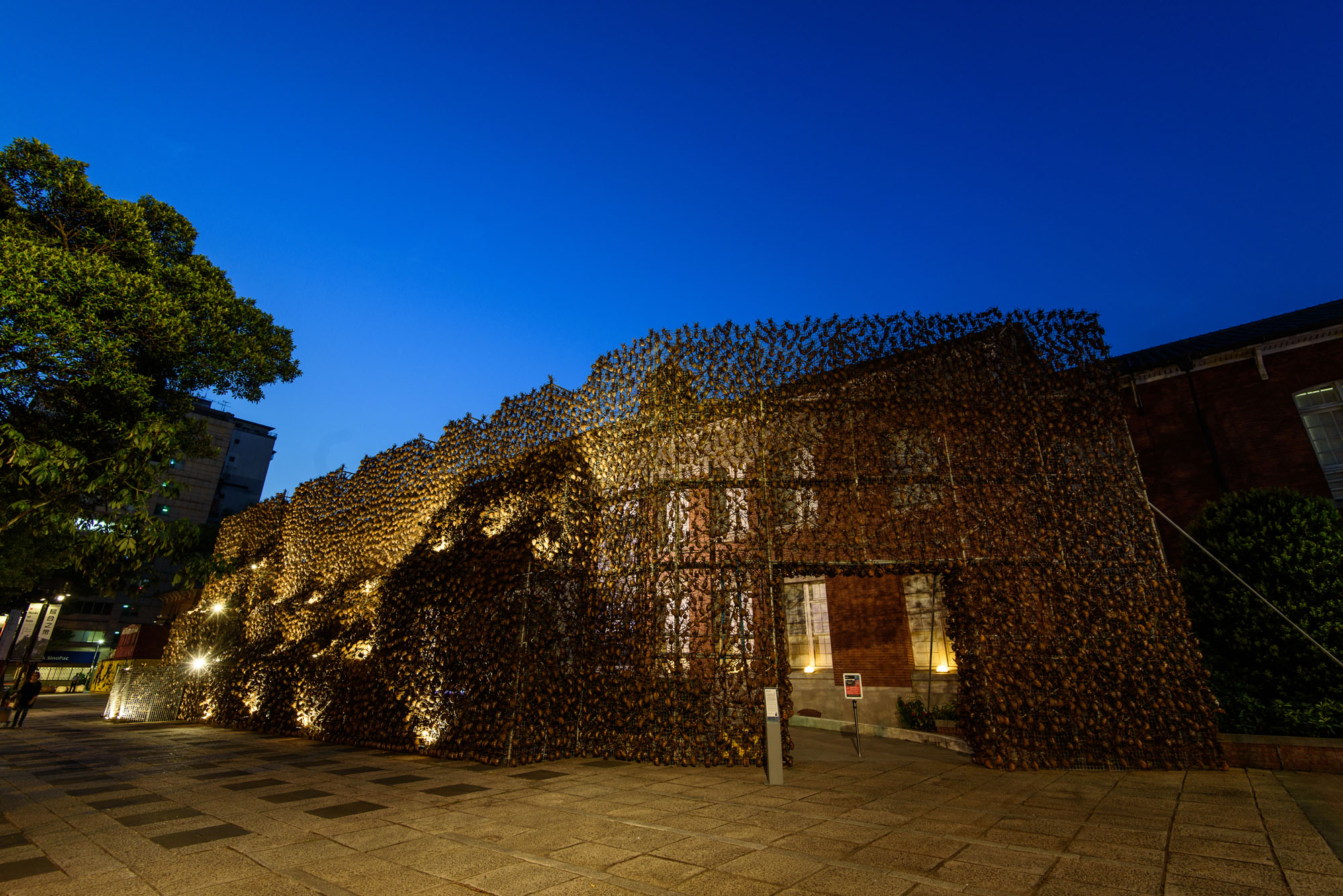

台北當代藝術館 官方網站 Museum of Contemporary Art, Taipei
Saturday 星期六
10AM - 6PM



Saturday 星期六
10AM - 6PM
EXHIBITIONS & EVENTS 展覽活動

2016 / 07 / 15 Fri.
2016 / 08 / 15 Mon.

一萬隻螞蟻構成的巨型裝置,頂著暑期酷熱的陽光和午後突來的西北雨,將台北當代藝術館的門面和建築層層包圍,透過視覺的放大與數量的繁多,藝術家陳志光用大眾熟悉的符號,意欲傳達他看世界的視角與方式。這些以赤鐵打造而表面長著褐黃銹斑的螞蟻大軍,是陳志光繼之前膾炙人口的電鍍七彩蟻和超大不鏽鋼蟻之後,從去年開始發展,一個别具新風、充滿視覺張力和時代意象的創作新系列。 A gigantic installation comprised of one thousand ants surrounds the front and the museum building under the scorching summer sun and the sudden afternoon showers. Through its giant size and massive number, Chen Zhiguang employs a symbol that the public is familiar with to display his way of viewing the world. This army of ants cast in red iron with brown spots on the surface is a fresh, visually stimulating series that symbolizes our time after the artist has presented the electroplated, iridescent ants and the stainless steel mega-sized ants. 這個以「烏合之眾」為名的藝術螞蟻大軍,除了以低調素樸的生物樣態象徵著各式各樣的小人物和社會群眾,藝術家也表明了此次希望藉用質樸價廉的赤鐵材料,特別打造一批最终可讓一般人士持分共享,而不是只能被少數收藏家壟斷獨擁的藝術螞蟻;另外,鐵打的螞蟻大軍看似傾巢而出,群聚在一座美術館門前和廣場,除了形成一種奇觀和勝境,也賦與了一些聯想的意義,例如,它們或許也代表著眾多孜孜不倦地往上爬、想要爭取機會出頭,在藝術機構和殿堂展現自我,被社會大眾接納的藝術家們,換言之,這也可視為一個「登上藝術創作頂端、邁向歷史文化顛峰」的寓言裝置! This artistic army of ants, titled Herd of Ants, embodies a vast array of ordinary people in a low-profile and unadorned manner. The artist hopes to use this inexpensive material of red iron to create a bunch of artistic ants that could be shared with the general public rather than being monopolized by a handful of art collectors. Moreover, the iron-cast ant army gathering in front of a museum and on its plaza has formed a spectacular site and created an opportunity of free association. For example, they could represent the diligent, hardworking artists who are endeavoring for a chance to show themselves in art institutions and be accepted by the public. In other words, the work could also be viewed as an allegorical installation that epitomizes "climbing to the top of artistic creation and soaring to the peak of history and culture." 陳志光一九六三年生於漳州,於福建師範大學美術系畢業後,從架上繪畫轉向雕塑藝術的自我研發,二OO三年以螞蟻雕塑奠定了獨特的造形體系與美學脈絡。在生物學上,螞蟻的種類超過一萬一千七百多種,印證了它們呼應外在不同環境而機轉適應的強大本能;在藝術創作中,陳志光藉由蟻族表徵人類不同的心理狀態與行為現象,歷年完成的每隻放大版的螞蟻,也因此都有著不同的心理參照與肢體語彙。 Born in Zhangzhou, China in 1963, Chen graduated from the Department of Fine Arts, Fujian Normal University and shifted from painting to sculpture after graduation. In 2003, the ant sculptures established a unique form and aesthetic context of his own. Biologically speaking, there are actually over ten thousand and seven hundred types of ants, proving their powerfully adaptability to different environment. In terms of artistic creation, Chen uses the ants as a metaphor for individual human psychology and behavior. Each enlarged ant that he has completed throughout the years stems from varying psychological state and body language. 做為陳志光雕塑藝術核心的『概念性』,先後演繹發展出了蟻族,荷池,戱台,靜物供桌...等不同的作品系列,也普獲許多策展人的肯定和各地機構的展覽邀約,這當中,唯獨螞蟻雕塑不斷衍變發展而從未間斷---螞蟻無疑已成為其雕塑藝術的旗標和美學認同的符號;而正如螞蟻之繁衍不息,陳志光對螞蟻藝術的創作發展,也有著源源不絕的靈感,從單體造型,英姿昂揚的獨立螞蟻雕塑,轉向呈現一種叢集的生命樣態,乃至於一種戲劇化的群聚行動,使作品進而與不同空間場域互相呼應,並在作品和不同時空與文化背景的觀賞者之間,預設了一些引發主動閱讀和積極對話的機制;綜合以上幾個不同論點,陳志光這次在台北當代藝術館「登場而不入室」的『烏合之眾』鐵雕螞蟻裝置大展,是相當具有「社會雕塑」意涵的! Artistic concept has always been at the core of Chen's sculpture, and he has developed various series, including the ants, lotus pond, opera stage, still life on the altar, etc. His work has been positively received by many curators and have been shown in exhibitions around the world. Among these series, the ant sculpture is the only one that has kept evolving—ants have undoubtedly become his sculptural signature and symbol of aesthetic identification. Like the constant propagation of ants, Chen also has continuous inspiration for his creation of ants. From a single ant sculpture that is heroically free-standing, to the representation of ants in groups, to the dramatic collective action of ants, these works echo their surrounding space and invite reading and dialogue from their viewers of different age and cultural background. Therefore, Chen's exhibition of the iron ants in front of the MoCA, Taipei, which "visit but not enter the museum," could actually be viewed as a kind of "social sculpture." 『烏合之眾』也是陳志光首次在台灣舉行的個展,一萬隻螞蟻爬向台北當代藝術館這座古蹟建築的創作構想,以及反諷的展覽名稱,敢情也傳達了他對於藝文生態現象的個人解讀,和一種自我解嘲的態度。對專程來訪或不經意遇見這個展覧的所有觀眾,藝術家誠摯的期待則是,每個人可以很輕鬆自在地,從視覺的相逢邂逅,延伸到精神意義的提煉和分享,乃至於情感內涵的共鳴與交流。 Herd of Ants is Chen's first solo exhibition in Taiwan. The creative idea of thousand ants crawling towards the museum as well as the sarcastic exhibition title in Chinese convey his personal interpretation of the artistic and cultural environment and his humorous attitude. Whether visitors come to the exhibition to see the work or simply happen to pass by, the artist sincerely hopes that everyone could have a relaxing time to enter a viewing process of first seeing the artwork, receiving and sharing its meaning, and eventually enjoying an inner resonance and exchange of feelings.
MORE
LESS
1963出生於福建廈門。1988年畢業于福建師範大學美術系,美國國務院國際訪問者領袖專案成員,中國雕塑學會常務理事,中國美術家協會會員,福建師範大學當代藝術研究所所長。
Born in Xiamen, Fujian, China in 1963, Chen graduated from the Department of Fine Arts, Fujian Normal University in 1988. He has been a member of the International Visiting Leadership Project hosted by the US Department of State, an executive council member of the China Sculpture Institute, and the director of the Graduate Institute of Contemporary Art at Fujian Normal University.
1991年生於福建漳州, 2014年畢業於中央美術學院版畫系,目前就讀中央美術學院研究生,現工作生活於北京。
Born in Zhanzhou, Fujian, China in 1991, Chen graduated from the Department of Printmaking, China Central Academy of Fine Arts (CAFA). He is a graduate student at CAFA, and lives and works in Beijing.
CLOSE
CLOSE
著作權聲明
台北當代藝術館尊重他人著作權,台北當代藝術館服務條款亦明定,網友使用台北當代藝術館服務不得侵害他人之著作權,因此,台北當代藝術館呼籲使用者同樣尊重他人之著作權。如果您認為台北當代藝術館網站中之任何網頁內容或網友使用台北當代藝術館服務已侵害您的著作權,建議您利用本處理辦法提出檢舉,台北當代藝術館客服中心將儘速為您處理:
若台北當代藝術館網站中之任何網頁內容或網友使用台北當代藝術館服務已侵害您的著作權,請您填寫:「 著作權侵權通知書」,且依該通知書所載提供下列資料及聲明,並以傳真的方式通知台北當代藝術館:
1、著作權人之簽名、或著作權人之代理人之簽名、相關權利證明文件及著作權之內容,例如:已發行書籍之封面及相關頁面、發表於網路中之網頁內容列印紙本及其網址。
2、侵害著作權之內容所在的網頁及網址。
3、您的聯絡地址、電話等資料。
4、書面聲明您確信該網頁內容的使用行為是未經過著作權人、其代理人或法律的授權。
5、書面聲明您於通知書所載相關資料均為真實,且您是著作權人或著作權人之代理人而為上開聲明。
若台北當代藝術館網站中之任何網頁內容或網友使用台北當代藝術館服務已侵害您的著作權,請您填寫:「 著作權侵權通知書」,且依該通知書所載提供下列資料及聲明,並以傳真的方式通知台北當代藝術館:
1、著作權人之簽名、或著作權人之代理人之簽名、相關權利證明文件及著作權之內容,例如:已發行書籍之封面及相關頁面、發表於網路中之網頁內容列印紙本及其網址。
2、侵害著作權之內容所在的網頁及網址。
3、您的聯絡地址、電話等資料。
4、書面聲明您確信該網頁內容的使用行為是未經過著作權人、其代理人或法律的授權。
5、書面聲明您於通知書所載相關資料均為真實,且您是著作權人或著作權人之代理人而為上開聲明。
隱私權保護政策
台北當代藝術館非常重視用戶的隱私權,因此制訂了隱私權保護政策。請你細讀以下有關隱私權保護政策的內容。
隱私權保護政策的適用範圍
1、隱私權保護政策內容,包括台北當代藝術館如何處理在用戶使用網站服務時收集到的身份識別資料,也包括台北當代藝術館如何處理在商業伙伴與台北當代藝術館合作時分享的任何身份識別資料。
2、隱私權保護政策不適用於台北當代藝術館以外的公司,也不適用於非台北當代藝術館所僱用或管理的人員。
3、台北當代藝術館在你註冊台北當代藝術館帳號、使用台北當代藝術館的產品或服務、瀏覽台北當代藝術館網頁、參加宣傳活動或贈獎遊戲時,台北當代藝術館會收集你的個人識別資料。台北當代藝術館也可以從商業夥伴處取得個人資料。
4、當你在台北當代藝術館註冊時,我們會問及你的姓名、電子郵件地址、出生日期、性別、職位、行業及個人興趣等資料。你在台北當代藝術館註冊成功,並登入使用我們的服務後,我們就會認識你。
5、台北當代藝術館也自動接收並紀錄你瀏覽器上的伺服器數值,包括互聯網協定位址 (IP Address) 、台北當代藝術館cookie中的資料及你要求取用的網頁紀錄。
6、台北當代藝術館會使用資料作以下用途:改進為你提供的廣告及網頁內容、完成你對某項產品的要求及通知你特別活動或新產品。
7、台北當代藝術館不會向任何人出售或出借你的個人識別資料。
8、在以下的情況下,台北當代藝術館會向政府機關、其他人士或公司提供你的個人識別資料:與其他人士或公司共用資料前取得你的同意。
9、需要與其他人士或公司共用你的資料,才能夠提供你要求的產品或服務。
10、向代表台北當代藝術館提供服務或產品的公司提供資料,以便向你提供產品或服務 (若我們沒有事先通知你,這些公司均無權使用我們提供的個人資料,作提供產品或服務以外的其他用途)。
11、應遵守法令或政府機關的要求。
12、我們發覺你在網站上的行為違反 台北當代藝術館服務條款或產品、服務的特定使用指南。
13、其他依「個人資料保護法」或政府法令應公開之資料。
14、為了保護使用者個人隱私, 我們無法為您查詢其他使用者的帳號資料,請您見諒!若您有相關法律上問題需查閱他人資料時,請務必向警政單位提出告訴,我們將全力配合警政單位調查並提供所有相關資料,以協助調查及破案!
15、 台北當代藝術館會到你的電腦設定並取用台北當代藝術館cookie。
16、台北當代藝術館容許在我們網頁上擺放廣告的廠商到你的電腦設定並取用cookie。其他公司將根據其自訂的隱私權保護政策,而並非本政策使用其cookie。其他廣告商或公司不能提取台北當代藝術館的cookie。
17、當台北當代藝術館進行與其產品及服務有關的工作時,會使用 web beacons 進入我們的網站網絡,提取cookie使用。
18、台北當代藝術館賦予你在任何時候修改個人台北當代藝術館帳號資料及偏好設定的權力,包括接受台北當代藝術館通知你特別活動或新產品的決定權。